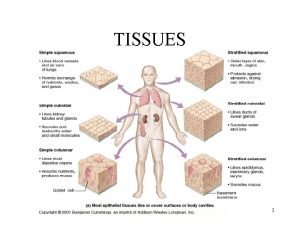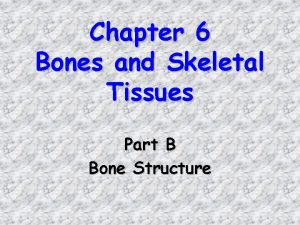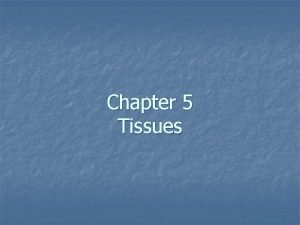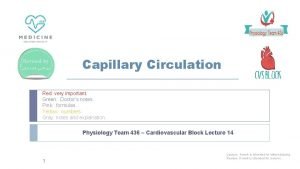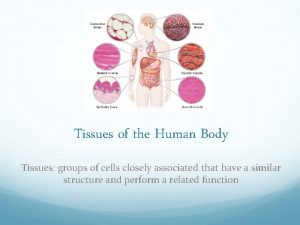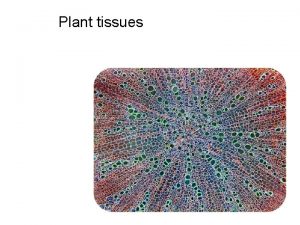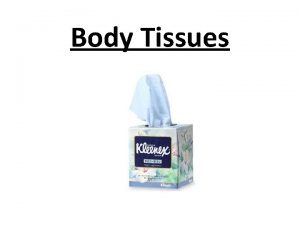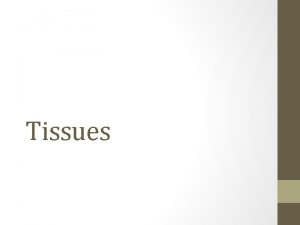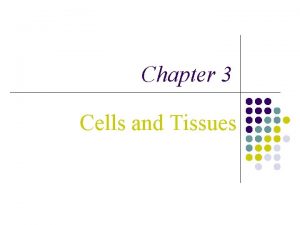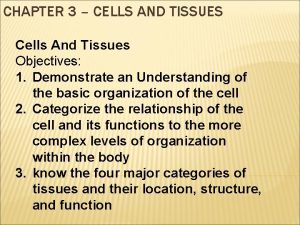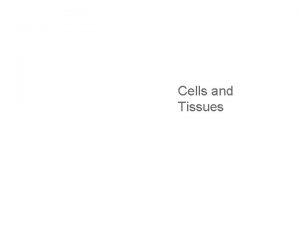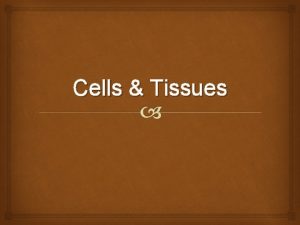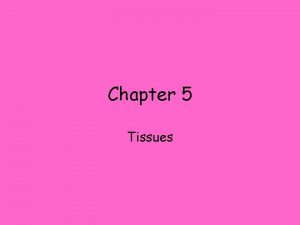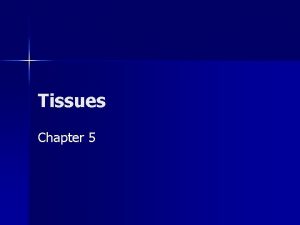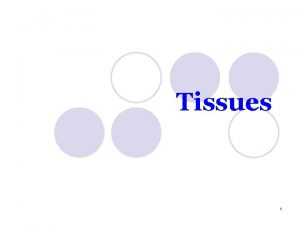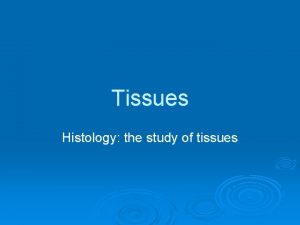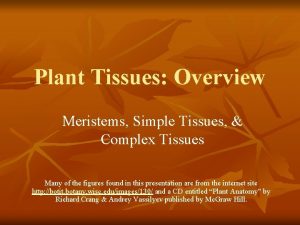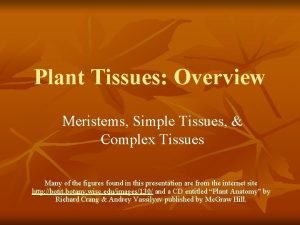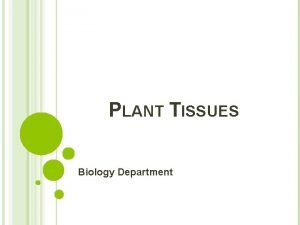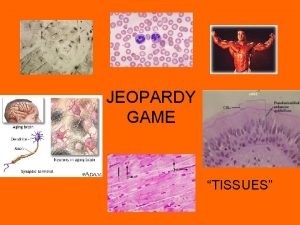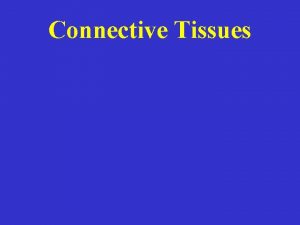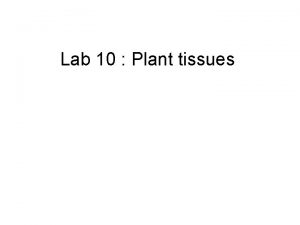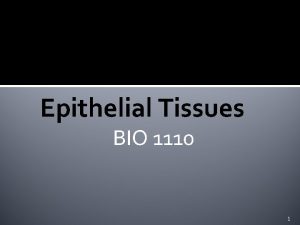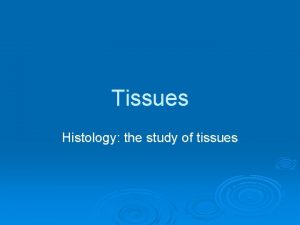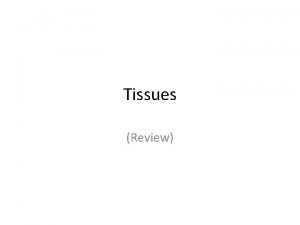Cells and Tissues Chapter 3 Cells and Tissues





































- Slides: 37

Cells and Tissues Chapter 3

Cells and Tissues • Carry out all chemical activities • Cells are the building blocks of all living things • Tissues are groups of cells that are similar in structure and function

Anatomy of the Cell • Cells are not all the same • All cells share general structures • All cells have three main regions ▫ Nucleus ▫ Cytoplasm ▫ Plasma membrane

The Nucleus • Control center of the cell ▫ Contains genetic material (DNA)

The Nucleus • Three regions ▫ Nuclear envelope (membrane) ▫ Nucleolus ▫ Chromatin

The Nucleus

The Nucleus • Nuclear envelope (membrane) ▫ Barrier of the nucleus ▫ Consists of a double membrane ▫ Contains nuclear pores that allow for exchange of material

The Nucleus • Nucleoli ▫ Nucleus contains one or more nucleoli ▫ Sites of ribosome assembly ▫ Ribosomes migrate into the cytoplasm through nuclear pores

The Nucleus • Chromatin ▫ ▫ Composed of DNA and protein Present when the cell is not dividing Scattered in the nucleus Condenses to form chromosomes when the cell divides

Comparing a Cell to a School • Use pages 66 -73 to complete the chart comparing a cell to a school • Fill in the cell organelle that best fits the described person or place • Write out the function of this organelle in a cell

Plasma Membrane • Barrier for cell contents • Double phospholipid layer ▫ Hydrophilic heads ▫ Hydrophobic tails • Also contains proteins, cholesterol, and glycoproteins

Plasma Membrane

Plasma Membrane Specializations • Microvilli ▫ Finger-like projections that increase surface area for absorption ▫ Do all cells have microvilli?

Plasma Membrane Specializations • Membrane junctions ▫ Tight junctions ▫ Desmosomes ▫ Gap junctions

Plasma Membrane Specializations • Membrane junctions ▫ Tight junctions �Impermeable junctions �Bind cells together into leak-proof sheets ▫ Desmosomes �Anchoring junctions that prevent cells from being pulled apart (Think ANCHORS) ▫ Gap junctions �Allow communication between cells (GAPS)

Plasma Membrane Specializations

Cytoplasm • Cytoplasm is the material outside the nucleus and inside the plasma membrane

Cytoplasm • Cytosol �Fluid that suspends other elements • Organelles �“Little organs” that perform functions • Inclusions �Stored nutrients or cell products

Cytoplasmic Organelles

Cytoplasmic Organelles • Mitochondria ▫ “Powerhouses” of the cell ▫ Carry out reactions: oxygen used to break down food ▫ Provides ATP

Cytoplasmic Organelles • Ribosomes ▫ Sites of protein synthesis ▫ Found at two locations: �Free in cytoplasm �Part of the Rough ER

Cytoplasmic Organelles • Endoplasmic reticulum (ER) ▫ Fluid-filled tubules for carrying substances

Cytoplasmic Organelles • Rough ER �Studded with ribosomes �Synthesizes proteins • Smooth ER �Lipid metabolism and detoxification of drugs and pesticides

Cytoplasmic Organelles • Golgi apparatus ▫ Modifies and packages proteins: �Secretory vesicles �Cell membrane components �Lysosomes

Proteins in cisterna Rough ER Cisterna Lysosome fuses with ingested substances Membrane Transport vesicle Golgi vesicle containing digestive enzymes becomes a lysosome Pathway 3 Golgi apparatus Pathway 1 Golgi vesicle containing proteins to be secreted becomes a secretory vesicle Pathway 2 Secretory vesicles Proteins Secretion by exocytosis Golgi vesicle containing membrane components fuses with the plasma membrane Plasma membrane Extracellular fluid

Cytoplasmic Organelles • Lysosomes ▫ Contain enzymes that digest worn-out or non-usable materials within the cell

Cytoplasmic Organelles • Peroxisomes ▫ Membranous sacs of oxidase enzymes �Detoxify harmful substances �Break down free radicals (highly reactive chemicals) ▫ Replicate by pinching in half

Cytoplasmic Organelles • Cytoskeleton ▫ Network of protein structures that extend throughout the cytoplasm ▫ Internal framework/structure

Cytoplasmic Organelles • Cytoskeleton ▫ Three different types: �Microfilaments (largest) �Intermediate filaments �Microtubules (smallest)

Cytoplasmic Organelles • Centrioles ▫ Rod-shaped bodies made of microtubules ▫ Direct the formation of mitotic spindle during cell division

Cellular Projections • Not found in all cells • Used for movement

Cellular Projections • Cilia: move materials across the cell surface �Located in the respiratory system to move mucus • Flagella: propel the cell �The only cell in the human body with flagella is sperm

Human Cheek Cells • Unstained

Human Cheek Cells • Stained – Low

Human Cheek Cells • Stained – High

Human Cheek Cells • Stained – High (Labeled)

Other Cell Examples • Skin • Muscle (cardiac)
 Body tissues chapter 3 cells and tissues
Body tissues chapter 3 cells and tissues Body tissues chapter 3 cells and tissues
Body tissues chapter 3 cells and tissues Body tissues chapter 3 cells and tissues
Body tissues chapter 3 cells and tissues Body tissues chapter 3 cells and tissues
Body tissues chapter 3 cells and tissues Cells form tissues. tissues form __________.
Cells form tissues. tissues form __________. Which part of the cell contains genetic material
Which part of the cell contains genetic material Chapter 3 cells and tissues figure 3-7
Chapter 3 cells and tissues figure 3-7 What is the function of the golgi apparatus
What is the function of the golgi apparatus Tissues are groups of similar cells working together to
Tissues are groups of similar cells working together to Tissues are groups of similar cells working together to
Tissues are groups of similar cells working together to Cells-tissues-organ-systems-organism
Cells-tissues-organ-systems-organism A group of cells similar in structure and function
A group of cells similar in structure and function Nondisjunction in meiosis
Nondisjunction in meiosis Chapter 6 bones and skeletal tissues
Chapter 6 bones and skeletal tissues Pns water view position
Pns water view position Chlorocruorin
Chlorocruorin Plant cell animal cell venn diagram
Plant cell animal cell venn diagram Masses of cells form and steal nutrients from healthy cells
Masses of cells form and steal nutrients from healthy cells Chapter 5 tissues
Chapter 5 tissues Dr saja
Dr saja Parafollicular
Parafollicular Somatic cells vs gametes
Somatic cells vs gametes Why dna is more stable than rna?
Why dna is more stable than rna? Eukaryotic cells vs prokaryotic
Eukaryotic cells vs prokaryotic Prokaryotes vs eukaryotes venn diagram
Prokaryotes vs eukaryotes venn diagram The organelle trail
The organelle trail Younger cells cuboidal older cells flattened
Younger cells cuboidal older cells flattened Are plant cells prokaryotic or eukaryotic
Are plant cells prokaryotic or eukaryotic Are red blood cells prokaryotic
Are red blood cells prokaryotic Cells and life lesson 1 answer key
Cells and life lesson 1 answer key Arterial vs venous end of capillary
Arterial vs venous end of capillary Fetal station chart
Fetal station chart Specialized connective tissues
Specialized connective tissues Types of tissues
Types of tissues Helianthus stem
Helianthus stem 3 tissues of a plant
3 tissues of a plant Photosynthetic cells
Photosynthetic cells Hannah campion
Hannah campion









